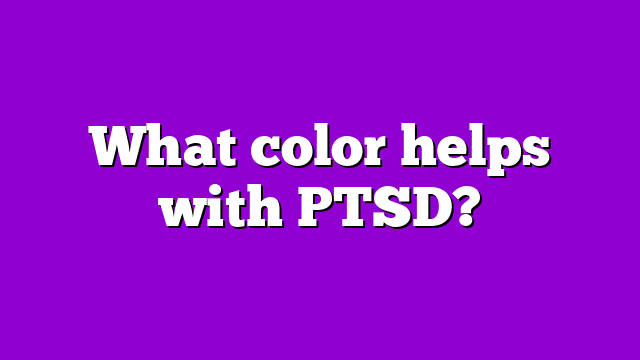Crystal Healing & Well-being
What color helps with PTSD?
When it comes to PTSD, there is no one color that will magically cure symptoms overnight. However, certain colors can aid in the healing process by promoting relaxation, reducing anxiety, and soothing the nervous system. Color therapy, also known as chromotherapy, involves using specific colors to promote physical and emotional healing. In the case of trauma, color therapy can be an effective tool for managing PTSD symptoms such as flashbacks, nightmares, and anxiety.
Some colors that can be beneficial for individuals with PTSD include:
- Blue: This color promotes tranquility and can help reduce feelings of stress and anxiety. Blue is also known to lower blood pressure and heart rate, which can be beneficial for those experiencing hyperarousal symptoms.
- Green: A calming and grounding color, green can help reduce anxiety and promote feelings of balance and harmony.
- Purple: Associated with spiritual healing and inner peace, purple can be beneficial for individuals experiencing PTSD-related nightmares and insomnia.
- Yellow: This bright and cheerful color can help boost mood and energy levels. Yellow is also known to stimulate the nervous system and promote focus and concentration.
- Pink: A soft and soothing color, pink can promote feelings of love and compassion. It can be particularly helpful for individuals experiencing emotional numbness or detachment.
Overall, color therapy can be a helpful tool for managing PTSD symptoms and promoting healing. It should be used in conjunction with other forms of therapy and treatment, and individuals should work with a qualified practitioner to determine which colors will be most beneficial for their specific needs.
Table Of Contents
- 1 The power of color therapy in healing trauma
- 2 How different colors affect the mind and body
- 3 The role of color in managing PTSD symptoms
- 4 Understanding the chakra system and its connection to color therapy
- 5 Using color visualization techniques as a form of therapy
- 6 Incorporating color into daily life for improved well-being
- 7 The science behind color therapy and its effectiveness in treating trauma
The power of color therapy in healing trauma
Trauma can have a profound impact on a person’s physical, emotional, and mental well-being. It can leave lasting scars that can be difficult to heal. Fortunately, there are a variety of therapies available to help individuals work through and manage the symptoms of trauma. One of the most effective of these therapies is color therapy. Color therapy, also known as chromotherapy, is a holistic therapy that uses the power of color to promote healing and well-being.
How different colors affect the mind and body
Colors have been shown to have a powerful impact on the mind and body. Each color has its own unique vibrations and energy that can affect our moods, emotions, and physical health. For example, red is associated with energy, passion, and strength, while blue is associated with calmness and tranquility. Green is often associated with growth and hope, while yellow is associated with happiness and positivity.
The role of color in managing PTSD symptoms
PTSD, or post-traumatic stress disorder, is a debilitating condition that can leave individuals feeling helpless and overwhelmed. However, research has shown that color therapy can be a highly effective tool in managing and reducing the symptoms of PTSD. Different colors can affect the brain in different ways, and by using color therapy, individuals can learn to regulate their emotions, reduce anxiety, and promote healing.
Understanding the chakra system and its connection to color therapy
The chakra system is an ancient healing practice that is closely related to color therapy. The chakras are seven energy centers in the body that are associated with different colors and emotions. Each chakra is associated with a specific color, and by using color therapy, individuals can balance and activate these energy centers, promoting overall health and well-being.
Using color visualization techniques as a form of therapy
Another effective way to use color therapy for trauma is through visualization techniques. This involves visualizing different colors in the mind’s eye and focusing on their energy and vibrations to promote healing and relaxation. This technique can be especially helpful for individuals who have difficulty verbalizing their emotions or who find traditional talk therapy to be overwhelming or triggering.
Incorporating color into daily life for improved well-being
In addition to formal color therapy sessions, individuals can also incorporate color into their daily lives to promote well-being. This can be as simple as choosing clothing or decor in calming colors or incorporating more colorful foods into their diet. By being intentional about the colors around us, we can promote healing and emotional regulation in our daily lives.
The science behind color therapy and its effectiveness in treating trauma
While color therapy may seem like an alternative or new age practice, there is a growing body of scientific research that supports its effectiveness in treating trauma. Studies have shown that color therapy can reduce symptoms of anxiety, depression, and PTSD, and promote overall emotional regulation and well-being. This is likely due to the impact that colors can have on the brain and our emotional and physical state.
Overall, color therapy is a powerful tool for healing and promoting well-being, especially for those who have experienced trauma. By understanding the power of color and its impact on our mind and body, individuals can use this therapy to manage their symptoms and promote healing in their daily lives.

